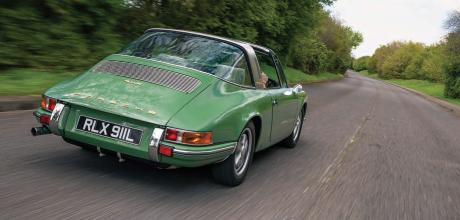1973 Porsche 911 E 2.4 Targa
The mystique of the barn find is strong. As this fully restored 911 E 2.4 Targa ably demonstrates, it’s also a rich source of Rindt Vehicle Design restoration projects, the kind many other specialists dare not get involved with...
Words Steve Bennett
Photography Dan Sherwood
REBORN IN A BARN
A fully restored Leaf Green 1973 Porsche 911 E 2.4 Targa
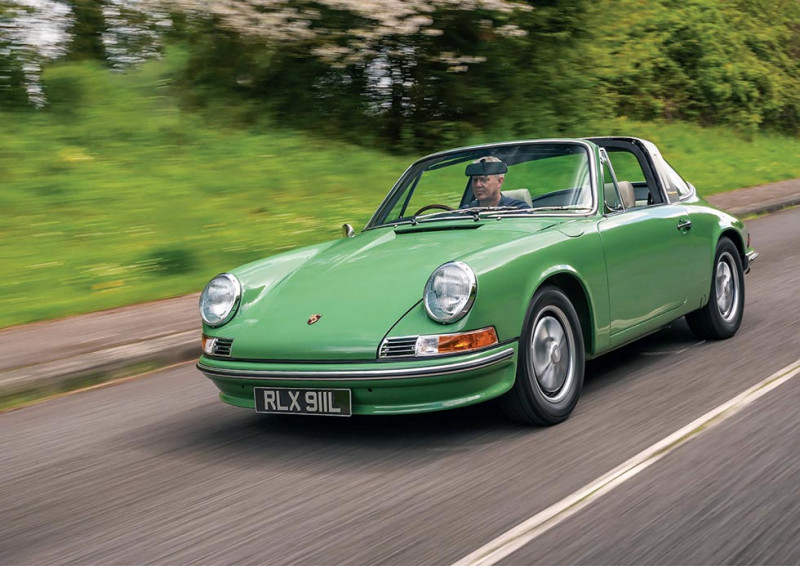
Barn find. There’s a couple of words to excite the Porsche bounty hunter in all of us. Of course, it’s a term covering all discovery bases — universal lingo for damp garage find, under a hedge find, in the corner of a field find and so on. Whatever the location, whatever the condition of the car, it doesn’t seem to matter. Barn find covers it all.
The attraction? Uncovering a dusty and rusty Porsche unseen for years might not be in the same league as Howard Carter breaking into Tutankhamen’s tomb in Egypt’s Valley of the Kings, but for your average Porsche hunter, it’s pretty damn close. The journey of discovery is even better if it has come about through random connections, rumour or hearsay. You know the sort. “That old farmer, Jim. He owns a fancy Porsche. Parked it up forty-odd years ago. It’s still there, stuck in that barn of his. Heaven knows what condition the car is in today.” See, you’re getting excited already. What farm, which barn?!
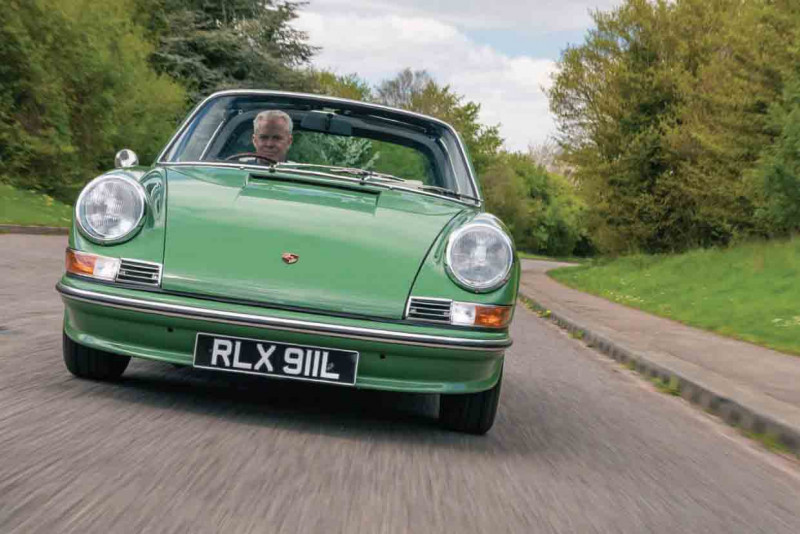
Just when you think all the barn finds have been discovered, another one presents itself. They keen on coming. Moreover, it’s easy to understand the fascination in uncovering an air-cooled Porsche that may not have seen the light of day for decades. It’s also worth keeping in mind the fact an old 911, 356, 912 or even a 914 tucked away in barn for a long period of time may not be in a bad way. Certainly, it’s not unusual for old Porsches in a state of suspended animation to remain unmolested.
This is obviously part of the appeal in an age when originality is often key to a historic vehicle’s financial worth. It’s also why today’s barn finds can command big money. It’s the opportunity to restore the unrestored. We’re back at Rindt Vehicle Design, just outside Windsor. These guys know a thing or two about barn finds. Indeed, such is their nose for a unearthing a Porsche previously considered lost, most of the cars restored and rebuilt by the company are exactly that, which is quite something, given the fact no fewer than twenty-two air-cooled classics are currently being afforded a new lease of life on what is essentially a Rindt Vehicle Design production line.
And, rather appropriately, this impressive operation is housed inside a generously sized old barn, albeit comprehensively updated to accommodate a Porsche restoration business.
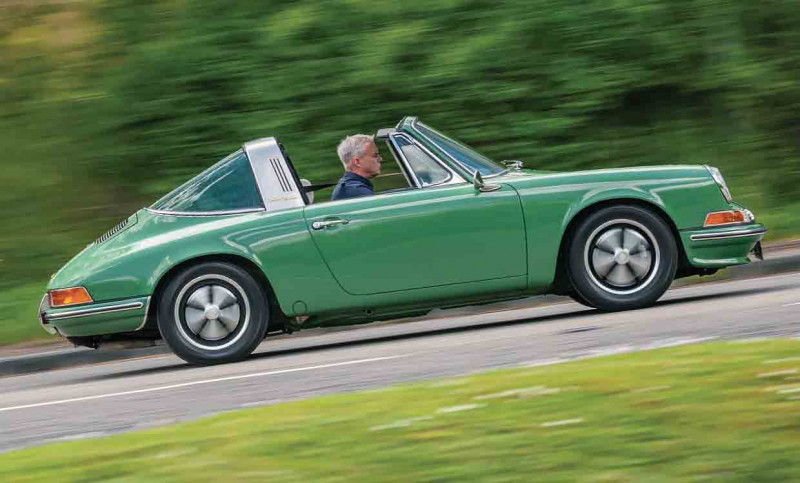
Is Rindt Vehicle Design simply lucky? Let’s face it, you make your own luck in life, and though you might be of the opinion ‘the harder they search, the more they find’, company boss, Brian Richardson, concedes oldPorsches often find him, often through word of mouth. That said, he’s happy to admit he has operatives scouring the country looking for long parked Porsches. On today’s visit, we’re at Rindt’s headquarters to get up close and personal with a gorgeous green 1973 911 E 2.4 Targa. You may have seen this semi-open-top Porsche in its embryonic state in photographs we published in the Rindt Vehicle Design company profile featured in the December 2022 issue of Classic Porsche. Brian sleuthed-out this particular 911 himself, finding it in a barn in Norfolk. Yes, it really is a genuine barn find. We can’t say whether it belonged to an old farmer named Jim, though. In fact, we can’t really say who it belonged to — it came as part of a property purchase and was accompanied by little more than an old logbook, which elicited very little information.
AUTOBAHN STORMER
The car was in a shocking state, a condition shocking enough to deter many seasoned restorers. Brian and Rindt Vehicle Design director, Trevor Ward, are of the thinking any Porsche can be saved, no matter its condition. It’s hard to disagree, but this is surely to ignore the economies of such an endeavour? This is where Rindt’s near unique business model comes into play. You see, the giant barn and surrounding outbuildings the company occupies amount to a onestop restoration shop. It’s not too far-fetched to call this place a restoration factory, where Porsches arrive in varying states of decrepitude. They enter one end of the building in disrepair and, months later, emerge at the other fully restored. In between this A-to-B, all the restoration work is carried out on-site by a super-skilled team of bodywork and paint magicians, engine builders, mechanics and trimmers.
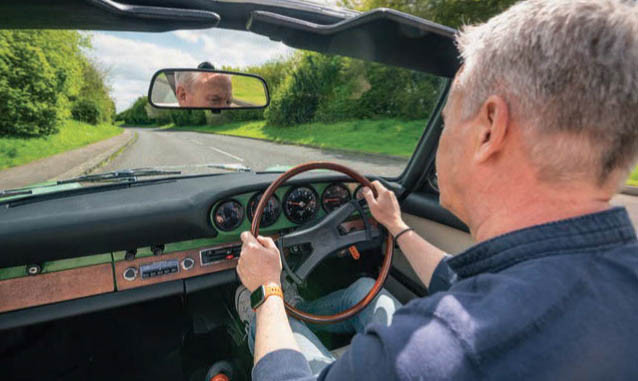
The point of all mentioning all this is to highlight the simple truth Rindt Vehicle Design can afford to take on Porsche restoration projects specialists at the mercy of thirdparty subcontractors might pass on. And so back to the 911 E 2.4 Targa you see on these pages. Clearly any barn-found Porsche is exciting, but this one piqued Brian’s interest for other reasons. “It’s a 911 with very unusual specification,” he says. “The paint colour is Leaf Green, which isn’t seen often.” Although this wasn’t a cost-option shade in 1973, it’s fair to say most Porsche showroom visitors in period opted for Irish Green, Conda Green or Viper Green. The more subtle Leaf Green was clearly too subtle for the vibrant early 1970s. “I’m convinced the original buyer was trying to emulate the look of an earlier short-wheelbase 911,” Brian reckons. “The car was optioned with a light cream-coloured vinyl interior and a dashboard finishedwith a wooden strip, which would have been very much a special order. Likewise, the car also makes use of a wood-rimmed steering wheel.”
Without wishing to jump the gun, it has to be said, this resurrected Targa looks stunning, but quite obviously, this isn’t how it arrived at Brian’s barn after the car was dug out from where it had been sleeping for many years. “Completely rotted out,” is his assessment. The first step was to place the shell onto one of Rindt Vehicle Design’s Celette jigs and then assess exactly what would was required to bring the car back to its best. The list was long, with only the bulkhead, engine lid, glass, door frames and basic monocoque salvageable. Full body restoration commenced and involved a mix of fabrication, utilising panels from Rindt’s extensive salvaged stock (“we’ve got fifty original doors to choose from”) and brand-new panels direct from Porsche.
The time taken to complete a job like this is entirely dependent on the condition of the car being treated to a new lease of life, but it’s reassuring to know all the required parts are available.
Due to high demand for Brian’s team obsessive attention to detail, Rindt Vehicle Design is about to open a second paint booth. “We use the Novol Paint System, the only paint coating system created specifically for classic motor vehicle restoration,” he reveals. “We mix our own paint, too. The Targa was subjected to eleven coats, each a different part of the process.” The finish speaks for itself.
THE WHEEL DEAL
While the body was undergoing months of reconstruction, the rest of the car was working its way through each of Rindt’s different restoration departments. Any reusable components were blasted, painted or plated. Unsurprisingly, the wiring loom had long ceased to be of any use, hence the construction of a new one. The only part of the process not completed in-house was the re-finishing of the wheels, a job Rindt entrusts to renowned Fuchs refurbisher, Art Wheels, based in Strasbourg, France.
The flat-six and gearbox are original to the car and underwent an equally fastidious rebuild in Rindt’s engine shop. The crank was deemed good, as were the connecting rods, but for all other components, well, you know the score. Surprisingly, perhaps, the mechanical fuel injection pump was in remarkably good shape and required only a spruce up, as opposed to the part being fully recommissioned.
In the trimming department, work was taking shape on the interior. The vinyl seats were upgraded to leather, but in the same colour. Additionally, the wood rim of the steering wheel and dash panel were restored. Brian’s team didn’t feel the need to be too precious about creating a like-for-like cabin, reasoning the original owner had seen fit to create their own look away from standard specification. It was therefore considered appropriate to trim the dash top and knee pad in leather, likewise the door panels. Finishing the panel surrounding the dash clocks in Leaf Green is another nod to the short-wheelbase look. One of Rindt VehicleDesign’s signature wooden gearknobs lets occupants know which company carried out the work.
From start to finish, the project was a near twelvemonth build. Let’s step back and soak it in. Let’s also pay tribute to the Targa look. It’s had its ups and downs, seemingly always in the shadow of the 911 coupe, but this distinctive body style, complete with rollover hoop, has found new favour with a generation of buyers pushing prices of early Targas to near parity with their hard-top siblings.
SLOW THE PACE
While we’re at it, a shout out for the fact this is a 911 E. The mid-range specification of the E, not to mention the modest 165bhp produced by the 2.4-litre flat-six, suits the cruising look of the Targa body style, which despite being named after a classic Sicilian road race, doesn’t encourage road race driving heroics. Maybe I’m just getting old? Well, yes, time marches on, but I do appreciate the whole Targa ethos much more than I ever used to.
Roof panel removed and stowed in the frunk, a 911 Targa is a great place to be. And unlike later, fatter 911s, this Leaf Green 911 E isn’t for hustling along. It responds to a lighter touch, it floats on its 195-profile Pirellis. Point it into a corner and it takes a while for the nose to stick, but then it’s easy to hold in a gentle drift. As we all know, the Type 915 gearbox isn’t for rushing, which makes the driving and shifting process a methodical one. There’s no point in speeding up to a corner, stamping on the brakes and expecting to quickly drop a couple gears. This kind of driving just ends in a mess of arms, legs and a box full of neutrals.
165bhp from the clattering, charismatic flat-six might not sound like much, but the Targa weighs in at around 1,090kgs. Power is more than adequate. It’s certainly enough for a sub-eight-second dash from rest to 60mph, romping on to almost 140mph. To focus on top scores is, however, to miss the point of this car, which should be thought of as less performance machine, more leisurely cruiser. Tune in to T-Rex on the period Motorola radio, use the ample torque, soak up the sights and breathe in the air flowing through the semi-open-top. We’re back in 1973.
This 911 is the perfect Porsche for a B-road saunter, rather than a B-road blast. Quite simply, it is a lovely, lovely thing. All the better for it being found in a barn and reborn in a barn.
165BHP FROM THE CHARISMATIC FLAT-SIX MIGHT NOT SOUND LIKE MUCH, BUT THE TARGA WEIGHS IN AT AROUND 1,090KGS
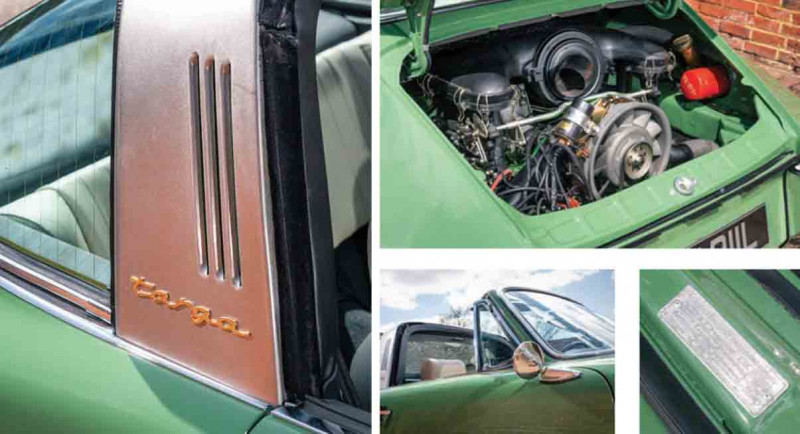
Above Rindt Vehicle Design tells us this 911 E 2.4 Targa has generated more interest on the company’s social media channels than almost any other restoration the firm has produced, save for the 964 Cabriolet converted to a wide-body coupe and featured in last month’s issue of Classic Porsche magazine.
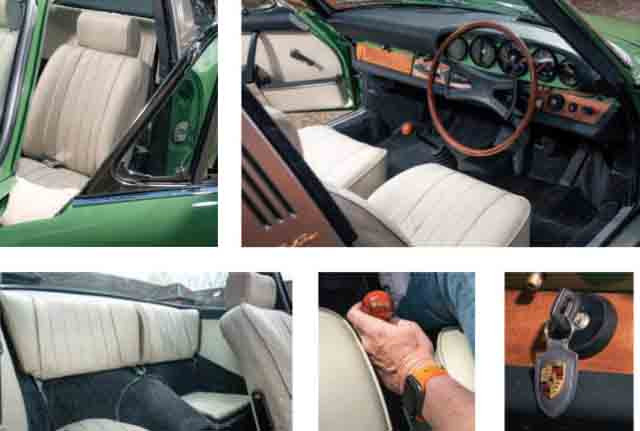
Above Targas were once seen as the poor relation in the 911 family, but the distinctive body style has made a comeback in recent years, undoubtedly helped by the 991-generation 911 Targa reverting to a rollover hoop in place of a convoluted panoramic roof mechanism Below Rindt Vehicle Design director, Trevor Ward, enjoying the sun on his face and the wind in his hair.
THE MECHANICAL FUEL INJECTION PUMP WAS IN REMARKABLY GOOD SHAPE AND REQUIRED ONLY A SPRUCE UP
Above Many restored are claimed to be based on barn finds, whereas this gorgeous green Targa really was discovered in a Norfolk barn, where it had been lying dormant for many years.
Above Leaf Green wasn’t a period cost option, but was rarely picked by buyers, who preferred darker greens Below Interior apes that of an earlier 911 and now benefits from a leather retrim in place of the original vinyl.


